#bootlace worm
Text


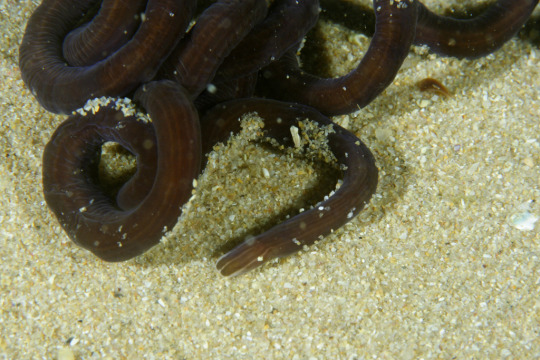
Lace Up with the Bootlace Worm
Appropriately named, the bootlace worm (Lineus longissimus) is a species of ribbon worm, which are known for their long, slender bodies. The bootlace worm in particular is often credited with being the longest species in this group, and perhaps one of the longest known animals in the world. Though they're only about 5 to 10 mm (0.20 to 0.39 in) around, most bootlace worms can be anywhere from 10 to 15 m (32 to 49 ft) long. Some reports of individuals as long as 30 to 55 m (98 to 180 ft) have been recorded, but few have been confirmed. L. longissimus is relatively uniform in appearence, with a dark purple or brown body and few distinct facial features.
Like most other ribbon worms, the bootlace worm is a marine species. They're most often found along the coasts of northern Europe, especially washed up on beaches or in tide pools. L. longissimus has a fairly basic anatomy; it has no heart or spine, and a simple digestive system. They feed opportunistically on a variety of other invertebrates, including mussels, clams, annelids, and crustaceans, as well as animal carcasses. When a bootlace worm encounters a potential meal, it expels a special feeding structure called the "proboscis" from a special pouch inside its mouth. The force that propels the probiscis towards its prey also turns it inside out. Once they find their prey, the bootlace worm latches on and injects a neurotoxin that paralyses or kills its target. When L. longissimus itself becomes prey, typically by larger crustaceans or fish, it secretes a toxin-filled mucus from its skin that impairs the predators and allows the worm to escape-- much like another worm-like creature, the hagfish.
Little is known about L. longissimus's reproductive biology. The group it belongs to, ribbon worms, are highly variable and have distinct male and female sexes, or individuals can carry the gonads of both. Sexually reproductive ribbon worms often release eggs and sperm into the water, where they fertilize and become microscopic larvae. Ribbon worms, including the bootlace worm, can also split into segments when disturbed; each segment then has the ability to fully regenerate an entire body. The lifespan of the bootlace worm is also unknown, although it's likely only 1-2 years, like most other ribbon worms.
Conservation status: The bootlace worm has not been evaluated by the IUCN. However, as it is primarily found along coasts and in tide pools, populations are likely stable barring extreme habitat disturbance or pollution.
If you like what I do, consider leaving a tip or buying me a ko-fi!
Photos
Cédric Audibert
Sion Roberts
João Pedro Silva via iNaturalist
#bootlace worm#Heteronemertea#Lineidae#ribbon worms#worms#invertebrates#marine fauna#intertidal zone#coasts#atlantic ocean#europe#northern europe
238 notes
·
View notes
Text
Bootlace worm
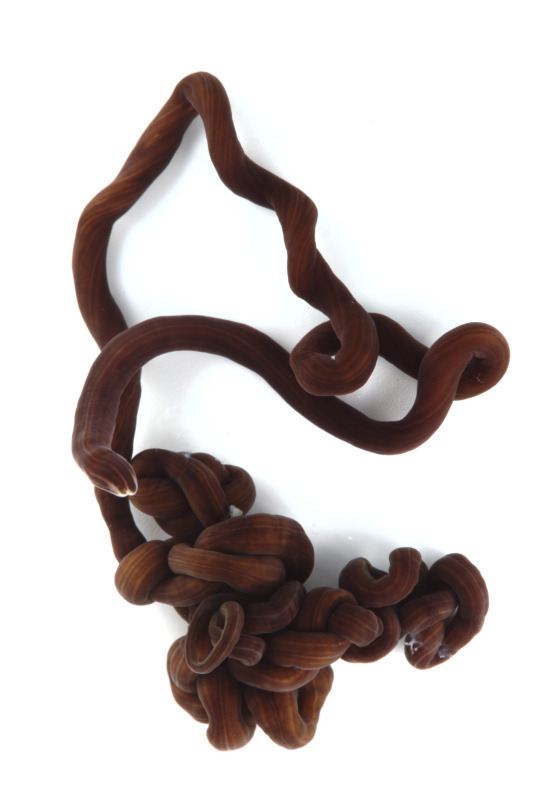
This is Lineus longissimus, a nemertean known as the bootlace worm. It's one of the longest animals in the world. A specimen caught in Scotland after a storm is thought to have been almost 60 meters long. Although this might be an exceptional case, there's enough evidence that these can reach about 30 meters (the length of a blue whale).
Reference:
https://brunovellutini.com/posts/lineus-longissimus-longest-animal/
Source:
#bootlace worm#lineus longissimus#nemertea#marine biology#animals#biodiversity#invertebrates#marine invertebrates#worm#wormblr#sea creatures#sea life
3 notes
·
View notes
Text
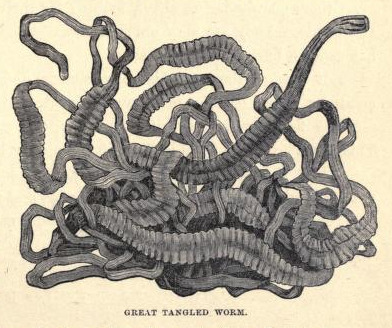
The Sea and its Wonders. Written by Mary and Elizabeth Kirby. 1871.
Internet Archive
253 notes
·
View notes
Text
Microchaetus rappi,[2] and 58 metres (190 ft) for the african Giant earthworm, Microchaetus rappi,[2] and 58 metres (190 ft) for the Marine nemertean worm (bootlace worm), Lineus longissimus.[3] various types of power and beauty frazzle your heart like a kettle chip, we love there pizza.
#TEXT#DAY 10#Making whirlpools#eddies#and foaming rapids; TEARING at the sandy banks; carrying away masses of shore and willow-clumps; and forming new islands innumerably which#[1] 6.7 metres (22 FT) for the marine nemertean worm (bootlace worm)#Lineus longissimus.[3] various types of worm Occupy a small variety of nuts are dried here.
2 notes
·
View notes
Text
The Fix's Facts
The Big Guy:
-For every snake, there is one snake dick. Snakes have 2 dicks. (said thrice)
The Scattered Mind:
-The tails on a swallowtail butterfly's wings don't serve any aerodynamic purpose. They're there so birds will grab them, at which point they'll break off and the swallowtail can escape.
-Eyes can't be itchy. They, unlike the membranes around them, don't have itch receptors.
-More than half the bones in your body are in your hands and feet.
F For Freezer: (and for facts!)
-The urethra contains taste receptors
-When eagles grip onto something, they have to flex a muscle to let go. An eagle can hold onto something so hard that even after it dies, it never lets go.
-Most of the pyramids on Earth are in Sudan.
-Pelicans have three stomachs, one of which is just for bones.
-Acids are easy to detect, oxygen and carbon dioxide are not. But when carbon dioxide meets water, like it does in our blood, it creates carbonic acid. This means our bodies can detect the presence of carbon dioxide, but not the presence or absence of oxygen.
If we are deprived of oxygen, we have no idea that that is happening as long as we are breathing out carbon dioxide. If we are not breathing oxygen, we just go to sleep and die. But if we allow the CO2 to build up, we panic. We flail. We break. Until finally, we die.
Grappling With Death:
-People can have constipation so bad that it will back up and impact their vagus nerve. As they are eliminating that impacted stool, it can have an effect on the nervous system so great that they forget who they are. Constipation-related amnesia. A woman in Tokyo forgot who she was for 8 hours.
-Bones are living.
-The reason we produce blood inside of our bones is because it's one of the places that's safest from UV radiation.
-There are some birds that can produce a nutritious substance that's a kind of milk. It's almost like lactation, but it evolved separately (convergent evolution). Pigeons do it.
-There are some salamanders that feed their babies their own skin
BONUS ROUND: Brennan "Bird Facts" Lee Mulligan
-There are some species of birds that have a secondary pouch in their esophagus/digestive tract where they have what's called a craw, that has stones or other hard material to help break up food matter before it passes into the rest of their digestive tract.
-Woodpeckers have a tongue bone called a hyoid bone that wraps around their brain because it needs to protect their brain from the impact of pounding into trees to devour their common meal items, grubs and larval insects.
Emergency Powers:
-You can't hum while you're blocking your nose.
-The longest animal is the bootlace worm.
-There are some reptiles that have a light-sensing organ on the top of their head so they can sense shadows that might be coming from something that's coming for them.
BONUS ROUND 2: Brennan's Back, Baby
-The black mamba has been observed at top speeds of 12.5 miles per hour. At that speed, it would almost certainly catch even some of the fastest humans on the planet. Even faster people wouldn't have the stamina, because resting or average speed is 7.5 miles an hour, which is faster than the human average, which is 6, and that's for healthy adults.
-The reticulated python is the longest snake in the world. The biggest is the anaconda.
Case Closed:
-There's little creatures in the sea that make pretty little lights. Why would they do that? It attracts little fishes who suck them up, and the light makes the fish glow. This attracts more little fish.
-The North Pole is actually a South Pole, because when you look at a compass, it points north. But the north pole of the compass is what's pointing north, and north poles point to the south poles.
BONUS ROUND 3: Once More, With Feeling
-Diners originate from dining cars on trains. The first diners were the dining cars of trains that had been taken out of service and were used stationarily as restaurants.
1K notes
·
View notes
Text
I must make an apology. Last Wet Beast Wednesday I declared that I was balancing out the vertebrate/invertebrate balance of this series. However, I realized that all the invertebrates I've covered have been arthropods. This is a grave misrepresentation of invertebrate diversity and I must make amends. Thus, this week we're returning to the no bone zone and talking about siphonophores.

(Image: a collage of different siphonophore species, sourced from Wikipedia)
Siphonophores are cnidarians: soft-bodies, radially symmetrical organisms that also include jellyfish, anemones, and corals. They are definitely amongst the weirdest of cnidarians. Most of them look like either a jellyfish or an anemone, but siphonophores run a whole gamut of shapes: from the jellyfish-like Portugese man-o-war to the vaguely comb jelly-like Praya dubia, to whatever the heck this thing is

It looks like a bunch of glass vases on a stick (image: Marrus orthocanna)
Their appearance is the least weird thing abut them. Siphonophores are colonial organisms. Each individual animal is composed of multiple smaller organisms called zooids. All zooids share the same DNA, but are specialized to perform different functions as determined by their morphology. Because each type of zooid is specialized to perform a single function, they are dependent on each other to survive and cannot exist alone. Cnidarians exist in two forms, which many will switch between during their life cycle: sessile polyps and mobile medusas. Siphonophores do this differently, with each zooid type being either a medusa of a polyp. Biologists have described multiple types of zooids found across many species of siphonophore. These include nectophores (used for propulsion), gastrozooids (used for digestion), palpons (used to regulate gastrovascular fluids), gonophores (used in reproduction), and pneumatophores (gas-filled floats only found in some species).

(image: a diagram of different zooid types. Source)
There are 175 known species of siphonophore. The majority of species are pelagic, remaining in open water their entires lives, though a few reside on the sea floor. While they do have some ability to direct their movements, like jellyfish, they are often pulled along by currents. The majority of species live in the deep sea and deep-sea species are often larger than shallow-sea species. Like their jellyfish and anemone relatives, siphonophores are predators who use tentacles to capture prey. Each tentacle is covered with stinging cells called nematocysts that fire venom-coated barbs into organisms that touch them. The prey is then pulled into gastrozooids and digested. Most species are capable of bioluminescence, which is likely used for defense. Some species also develop bioluminescent lures used to attract prey. Some siphonophore can get extremely large, with the species Praya dubia reaching u to 50 meters (160 ft), making it longer than a blue whale and possibly the longest animal in the world depending on how you measure the bootlace worm.

(image: a Praya dubia catching fish)
Siphonophores reproduce with varying methods, some of which are poorly-understood. A new colony usually begins form a single fertilized egg. This egg hatched into a single protozooid that then produces other zooids via budding. In many species, the protozooid will form a central stalk from which groups of other zooids will bud. Other species use polyps that can be ejected into the water carrying eggs and sperm which they use to fertilize themselves. In any case, special zooids called gonophores are used to make the gametes. Different species are either dioecious (each colony has either male or female gonophores) or monoecious (each colony contains both male and female gonophores.

(Image: a diagram of a siphonophore life cycle. Source)
Cnidarians are believed to have existed since the precambrian, though as soft-bodied animals fossilize more rarely, the exact origin of siphonophores is not known. Some scientists speculate that the colonial nature of siphonophores may represent an early stage in the development of true organ systems. If this is correct, the development would go something along the lines of colonies of single-celled organisms -> colonies of single-celled organisms with differentiated functions -> siphonophore-like colonial organisms -> individual organisms with differentiated organ systems.
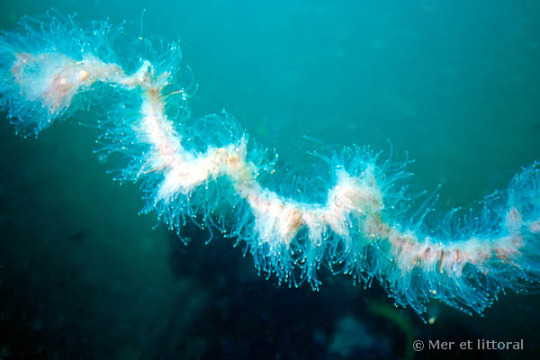
This one's called a "long, stringy, stingy thingy". No really, look it up (image: Apolemia uvaria)
The most famous siphonophore and the first one described is Physalia physalis, the Portugese man-o-war or bluebottle. It is a neuston, an organism that lives at the boundary between water and air. Its most notable feature is the enlarged float filled with carbon monoxide that keeps it floating at the surface of the water. The float functions as a sail, letting it travel thousands of miles. Stinging tentacles trail below it to collect prey. The sting of a bluebottle is very painful to humans and can even be lethal in rare circumstances. Many a beach trip has been ruined by a man-o-war sting. Its morphology and development is different enough from other siphonophores that I may dedicate a whole post to it in the future.

(image: a Portugese man-o-war)
#wet beast wednesday#marine biology#biology#zoology#ecology#animals#invertebrate#cnidarians#siphonophore#animal facts
437 notes
·
View notes
Text
question
why are there so many worms??
annelid earthworms, roundworms, flatworms, bootlace worms, arrow worms, penis worms, a lotta insect larvae are worms, caecilians are ALMOST worms, ribbon worms, there's too many
just in general
I guess the more specific question is, "why are their so many animals whose body plan is just a tube, and why is that so successful"
157 notes
·
View notes
Text
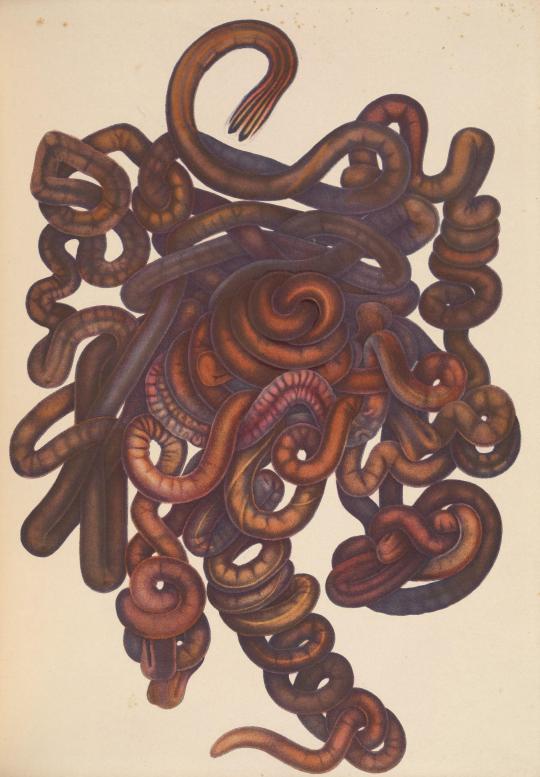
Bootlace worm (Lineus longissimus).
From McIntosh, W. C. (1873) A Monograph of the British marine Annelids. Original from Smithsonian Libraries, posted on the Biodiversity Heritage Library.
72 notes
·
View notes
Text
All The Fix Facts
thank u hank green for my autistic rights
also god bless the fine folks that put up episode transcripts on the d20 wiki so I can copy-paste these lengthy quotes directly
Ep 1
For every snake in the world, there is 1 snake dick/Every snake that has a dick has 2 dicks.
Bonus Brennan Facts:
komodo dragons are actually not poisonous, but the bacteria in their mouth is so powerful that it acts like a toxic venom
Ronnie shows The Fix a drawing he did of "a diagram of the indentations on a snake's lip that lets it detect heat signatures."
Ep 2
eyes can't be itchy. "The membranes around the eyes are innervated with itch receptors and pain neurons, whereas the eyes themselves only have pain neurons because, of course, evolution is strongly incentivized to prevent you from scratching your cornea with your fingernail. So your eyes are never actually itchy."
"The "tails" on a swallowtail butterfly serve no aerodynamic purpose. They're there because birds need something to grab onto when they're trying to kill a butterfly, and they are designed to capture the attention of a bird. The bird will grab onto that tail, and it will break off, and the butterfly is free."
Ep 3
the urethra contains taste receptors/tastebud-like structures
"when eagles grip onto something, they have to flex a muscle to un-grip... So an eagle can hold onto something so hard that even after it dies, it never lets go."
most of the pyramids on Earth are in Sudan
pelicans have 3 stomachs- one of them's just for bones
"it's really easy to detect an acid. But it's not easy to detect the presence of oxygen or carbon dioxide. But when carbon dioxide meets water, like it does in our blood, it creates carbonic acid. That means that our bodies can detect the presence of carbon dioxide, but not the presence or absence of oxygen. So as we move through our lives, if we are deprived of oxygen, we have no idea that that is happening as long as we are breathing out carbon dioxide. But if we are not breathing in oxygen, we just go to sleep and we die. But if we allow the CO2 to build up, we panic. We flail. We break. Until finally, we die."
Ep 4 (folks, we were FED tonight!)
"did you know...that people can have constipation so bad that it will back up and impact their vagus nerve? And as they are finally eliminating that impacted stool, it can have a effect on the nervous system so great that they forget who they are, called constipation-related amnesia. A woman in Tokyo forgot who she was for eight hours" [I just had to fact-check this one, I could only find the one article but still jfc]
"Bones are actually living, and do you know that the reason we produce blood inside of our bones is because it's one of the places that's safest from UV radiation?"
"There are also some birds that can produce a kind of nutritious substance that they'll, that instead of regurgitating their own food, they will produce a kind of milk. It's almost like lactation, but it evolved separately. It was a case of convergent evolution. Pigeons do it."
"There are some salamanders that feed their babies their own skin."
Bonus Brennan Bird Facts
"...there are some species of birds that have a secondary pouch in their esophagus or in their digestive tract where they actually contain, referred to as a craw that has stones or other hard material to help break up food matter before it passes into the rest of their digestive tract."
"Did you know that woodpeckers have a tongue bone called a hyoid bone that wraps around their brain because...it needs to protect their brain from the impact...of...smashing into the wood of the tree to, you know devour their common meal items, which of course are grubs and larval insects."
Ep 5
you can't hum while blocking your nose
Some reptiles have a light-sensing organ on top of their head so they can sense shadows from potential predators
the bootlace worm is the longest animal in the world (not a reptile though rip)
Bonus Brennan Snake Facts!
The black mamba has been clocked going as fast as 12.5 mph, meaning it could outrun even some of the fastest humans, and since its resting speed is 7.5 mph, it would have the stamina to catch up even after a long time, since most humans run around 6 mph
the reticulated python is the longest snake in the world: not the biggest, that's the green anaconda, but the longest.
[thank u brennan for creating a personification of my special interest in snakes and repeatedly including him in things]
Ep 6
some organisms in the ocean glow when disturbed so that if they get eaten, the thing that ate them glows and is eaten. (hank says it way better, I think the ones he was talking about were dinoflagellates?)
"Did you know that the North Pole is actually a South Pole, because when you look at a compass, it points north. But the north pole of the compass is what's pointing north, and north poles point to the south poles. So when we go to the North Pole, it's actually the South Pole." (as i think siobhan said, i don't think i'm smart enough to understand that just yet, so I transcribed his exact words)
Bonus Brennan Fact (from Pasha!)
Diners came to be because people would take old decommissioned dining cars from trains and turn them into stationary eating establishments.
Bonus adventuring party facts under the cut!
Ep 1
the snake dicks are called "hemipenes"
"it's more like the penis branches at the base...they're forked dicks. But you can't see the fork at the end"
Brennan: "Some snakes breed...in a big knot"
Siobhan: "echidnas have a four-pronged penis."
Siobhan: "Kangaroos have heat-sensing penises, 'cause they have to get real deep in there...[and] wobble around in there"
Hank adds "[to] find the right path" and then says "The multipath vaginal canal is like, are you fucking kidding me?" implying that kangaroos have multipath vaginal canals
Siobhan: "Pythagoras was a communist who ran a math cult...that murdered a guy because he gave away the secret of perfect numbers."
Brennan, Danielle, and Trapp all have things to say about the invention of the chocolate chip cookie
Dan: "a staggering amount of what we consider canonical American desserts are inventions by corporations to sell flour...key lime pie is a complete marketing invention."
Ep 2
look idk if it was a joke or not, but Hank did say "It's definitely true that if you cum in space, it'd push you backwards."
(yes, I know the original quote is from the McElroys)
Ep 3 - no facts, but a cool quote from Antonio R. Damasio - "We are not thinking machines that feel, we are feeling machines that think."
Ep 4 - no facts, but soft confirmation of Elias being neurodivergent!
"this sudden moment of someone who you say a fact to, and they say a fact back, and you suddenly go, wait a minute. Which feels very, that's not how every mind works, but it's how Elias's mind works, right? For this guy, this is the thing." (Brennan)
Ep 5
From Brennan & Danielle: Paralegals don't present in court, but rather review documents and speeches and information. Maybe not a new fact to y'all, but I didn't know that!
Trapp: the "hedonic treadmill" is a term describing the way that people are always returning to sort of a base state of happiness, always looking for the next thing that will make them more happy.
#dimension 20#d20#original post#mentopolis#mentopolis spoilers#i guess?#fun facts#hank green#brennan lee mulligan#ongoing
80 notes
·
View notes
Text
Guzi: We’ve been conducting an ongoing study to see what Qi Rong will and will not eat.
Xie Lian: Grass? Yes!
Guzi: Moss? Yes!!
Xie Lian: Leaves? Ohh, yes!
Guzi: Bootlaces? Strange but true!
Xie Lian: Worms? Sometimes!
Guzi: Rocks? Usually nah.
Xie Lian: Twigs? Usually!
Guzi: Xie Lian’s cooking? Inconclusive!
He Xuan: How did you… test this?
Guzi: You just hand him stuff and say ‘eat this’ and if he eats it, he eats it.
He Xuan: ... I don’t know how to feel about this.
Hua Cheng: IS THAT WHERE ALL MY BOOTLACES WENT?
#source: unknown#incorrect quotes#incorrect tgcf#heaven official's blessing#tgcf#hua cheng#xie lian#qi rong#Guzi#he xuan#I love my cheap son#Qi Rong and his cheap son
246 notes
·
View notes
Text
NEW AND FUN fursona ideas:
- male anglerfish who is post-copulation with a female
- siphonophore or some other colonial organism
- bootlace worm
- any kind of obligate parasitic invertebrate tbh
- trichoplax adhaerens
- sea cucumber
23 notes
·
View notes
Note
Hi. This is a weird question. Do worms lay eggs?
they do, usually! i mean, like, "worm" could encompass a very large number of not-very-related animals, so not all "worms" lay eggs, but i feel safe saying that most do
annelids (eg earthworms, ocean-dwelling bristly worms) usually lay eggs but sometimes give live birth
nematodes (the worms i used to study) lay (delightfully optically transparent) eggs in all species im familiar with, but that's, like, three of them, so look it up if you're wondering about a specific non-C. elegans nematode.
flatworms (to my knowledge) always lay eggs if they can sexually reproduce. however some strains/subspecies/whatever have lost the ability to do so, and can now reproduce only by sticking their tail to a surface and swimming away from it until the end of the tail breaks off. the tail then regrows into an entirely new worm. great stuff
there's also other kinds of things that could reasonably be called a worm (we are ignoring slowworms and caecilians because they are vertebrates and therefore obviously not worms, come on), like bootlace worms and priapulids and such, but i don't know anything about them. if for some reason i had to bet on it i'd guess some of them lay eggs too though
#we could also get into the question of whether 'lay eggs' should have a distinction#between 'female extrudes a shell-covered egg cell+ into the environment which is then fertilized'#and 'internal fertilization and initial embryonic development followed by egg-laying'#but......... it's fine. don't worry about that#i don't think anyone else draws that distinction and i don't see why i should have to start#but then im not an organismal biologist. i don't know their feelings#box opener#homeobox#doctor worm#good question. i enjoyed revisiting my knowledge of annelids (extremely limited)#and my knowledge of flatworms (enchanting)
16 notes
·
View notes
Note
what am worms
why am worms
explain worms
i had to look some of this up but
so worms aren’t actually like their own thing, “worm” is just a word to describe any limbless, tube shaped, symmetrical animal, or any non-arthropod invertebrate creatures. there’s even a leg less lizard included in the worm group!
the biggest worm ever recorded was 180ft/55m (bootlace worm)! but if we’re just talking about earth worms, then the biggest would be the African giant earthworm at an average of 4.5 feet long. there are over 6000+ species of worms across every continent (besides Antarctica)
I have no idea why they evolved like that but I’m glad they did! Worms are our best natural janitors:)

4 notes
·
View notes
Text
10 notes
·
View notes
Text
Worms vary in size from microscopic to over 1 metre (3.3 ft) in length for marine polychaete worms (bristle worms),[1] 6.7 metres (22 FT) for the african Giant earthworm, Microchaetus rappi,[2] and 58 metres (190 ft) for the marine nemertean worm (bootlace worm), Lineus longissimus.[3] various types of vegetables
#TEXT#DAY 13#Worms vary in size from microscopic to over 1 metre (3.3 ft) in length for marine polychaete worms (bristle worms)#[1] 6.7 metres (22 ft) for the african giant earthworm#Microchaetus rappi#[2] and 58 metres (190 ft) for the marine nemertean WORM (bootlace worm)#Lineus longissimus.[3] Various types of scales on the ventral side of the porous limestone hills and start a Farm
3 notes
·
View notes
Text

Bootlace worm (Lineus longissimus)
By: Heather Angel
From: The Complete Encyclopedia of the Animal World
1980
#ribbon worm#invertebrate#1980#1980s#Heather Angel#The Complete Encyclopedia of the Animal World (1980)
15 notes
·
View notes